#handloom lungi
Text
Top 17 Classic Suit for Men Meant for Amazing Groom Outfits
The ideal Suit for Men, with the best of designs and the best possible fit. That is something that every man requires. We have some incredible designs of suits for men of various types. The ideal black suit for men, or the combative blue suit for men, or even the elegant two-piece suit.
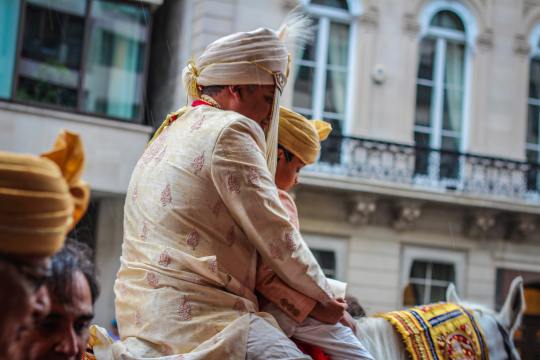
Typical Colour Suit for Men:
You're a fashion beast, and you must have at least one of the following colors in your closet. Who said men only have a few shots to try on? When you have all of the colors that are considered fashionable in every way.
Black suit for Men
Believe us when we say that black is a color that never goes out of style. Although this is not a green color, it will remain fashionable indefinitely. So, in our opinion, investing in one goof Black suit over cotton vest for Men is a wise decision. You can simply put your heart and soul into this suit and wear it according to the occasion.
Blue Suit for Men
Blue is another color that will undoubtedly look good on any man. If you're a black guy looking for a new suit for the big day, go for a Blue suit for Men. These colors are understated and sophisticated. Without a doubt, you'll ace it.
Brown Suits for Men
Brown is most likely your Bae if you enjoy shopping for new and fashionable clothing for any occasion. Brown was a retro color that resurfaced in fashion after Vogue's falling runaway shots. Wear your Brown Suit for Men with all of your elegance.
Grey Suits for Men
Grey is a very lovely color, isn't it? Especially when you know it will undoubtedly make you look hot. Wear the Grey 2 piece suit for Men and pair it with your stainless steel watch.
White and Off-White Suit for Men
Many would consider this a poor decision, especially when purchasing a Suit for Men, but we believe it is a steal. And the reason for this is that you can wear a white suit to anything and everything.
Olive Green Suits for Men
The color appears to be the best option ever, right? Because it is the best color to wear for any formal or non-formal occasion. Without a doubt, you can do it.
Red or Rust Suits for Men
The color red is not just for girls, as you can wear it brilliantly with a simple suit for us. In every way, the elegance of these suits is out of this world. Red is a very versatile and outgoing color in every way.
Moods in Suits for Men:
Who said moods were only for women? Suits for Men have their own personalised moods, which are worn depending on the occasion and time of day. The following men's suits are very different from one another. So, choose it based on your mood and event.
Indo-Western Suits for Men
The Indo-Western appearance of a Suit for Men is on the average. That is similar to a Western suit, but also to a Kurta or Sherwani, and is appropriate for a New Groom's or wedding guest's attire.
Coffee Date or Lounge Suit
The coffee date must wear a nice blazer suit that reminds you of Scottish or Irish coffee shops. The lounge suit for men is an informal or casual suit for men that comes in a variety of colors such as coffee brown, black-grey, and blue Scottish Blue.
Mandarin Suit and Royalty
This is a favorite of Asian royalty, and it is also their cultural Suit for Men. The overall design is similar to the Ind-Western Suits we're used to, but the collars are round or Chinese in shape. Which is the specialty of such men's suits.
Blazer Suits for the Dude
This is a throwaway suit for men, as it is only meant to be worn as a simple overcoat blazer on their outfit. By incorporating a simple blue suit for men, or even a black suit for men, a simple look can be transformed into a perfect formal or official look.
Formal Men’s Collection:
There are several options available for a formal or official appearance. However, the most elegant and formal look has to be with the following men's suits. These are attractive options with their own distinct specialties.
Double Breasted Suits for Men
This suit has two separate joints, the first at the point where you would normally put the buttons on a blazer suit. These suits for men have joints and separate buttons, while another joins a bit interior to the suit.
The Three-Piece Elegance
The three-piece suits have separate sections for men. Separate colored trousers, a Tuxedo jacket, and an overcoat blazer are especially appropriate. These are the three paired suits for men, which could be a black suit or a blue suit.
The official ‘2 piece Suit’
This common two-piece suit comes in a variety of styles. As an example, a pair of trousers and a blazer, or a Tuxedo and a blazer. The two-piece suit is extremely popular among officials and even at weddings. The men's special suit comes in a variety of colors and designs.
Classic Tuxedo
The classic tuxedo design is timeless and adaptable in every way. The outfits are simple, consisting of a sleeveless blazer jacket worn over a shirt and a trouser. No overcoat, blazer, or anything else.
Aside from the options listed above, there are several others that a man can wear for special occasions. For example, a well-stitched shirt or a Pathani suit paired with handloom lungi.
0 notes
Text





#amrutcreation#handloom#textiles#garment#manufacturing#wovenclothing#firstmanufacturer#supplier#clothing#manufacturespowerloom#cottonsarees#traditionalbath#towels#lungis#plainpowerloomscottonfabric#powerloomfactory#firstandonlyunitinKodagu#specialize#sophisticated#sewingmachines#cutting-edge#creatinguniforms#uniformsschoolsandcolleges#uniformsCorporates#uniformshospitals#uniformshotels#uniformsrestaurantsandautomobile#uniformskhakishirtsandhomeguards
0 notes
Text
Buy Handloom Lungies Online Shopping
The marriage season is at bay, and you must effectively concentrate on shopping for new clothes for the forthcoming marriage season. As we're short on time, it's now necessary to concentrate on completing your shopping as soon as possible, or differently you'll make it too late, and also you'll have to settle with poor quality outfits. Suppose you're planning to attend a south Indian marriage. In that case, you should surely conclude to buy handloom lungies online, as it'll help you effectively show authentic South Indian fashion.
0 notes
Text
Unveiling the Splendor of Ancient Indian Clothing and Style
India's rich history is adorned with a tapestry of clothing and fashion that has evolved over the centuries. From the Vedic times to the Indus Valley civilization, the clothing of ancient India tells a captivating story of tradition, culture, and artistry. In this blog post, we dive into the remarkable world of ancient Indian clothing, exploring the styles, fabrics, and colors that adorned both men and women. Let's embark on a journey back in time to discover the fascinating attire that shaped the fashion landscape of ancient India.

Clothing and Style for Men:
Dhoti: A cloth wrapped around the waist and knotted at the back.

Antariya: A white cotton or muslin cloth tied to the waist, accompanied by a sash called Kayabandh and a scarf called Uttariya.

Turban: A cloth wrapped around the head, often symbolizing social status and identity.

Phetas: Special turbans worn for religious purposes.
There are numerous types of phetas which are being used in different places across India for different purposes.
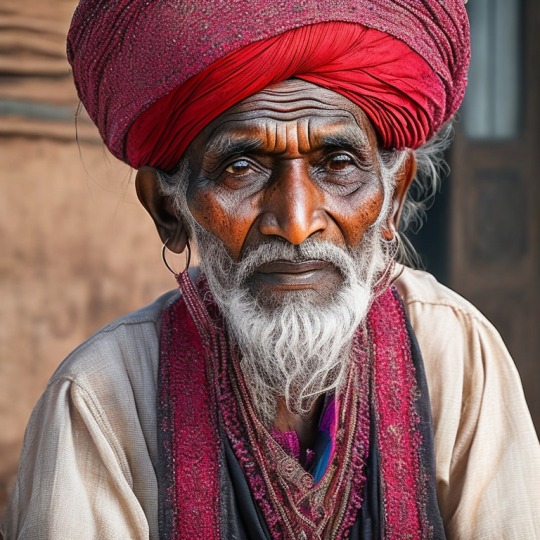
Peplon or chiton: Layered clothing made of linen and wool, adjusted according to weather conditions.

Man-buns and short or shaved beards were popular styles

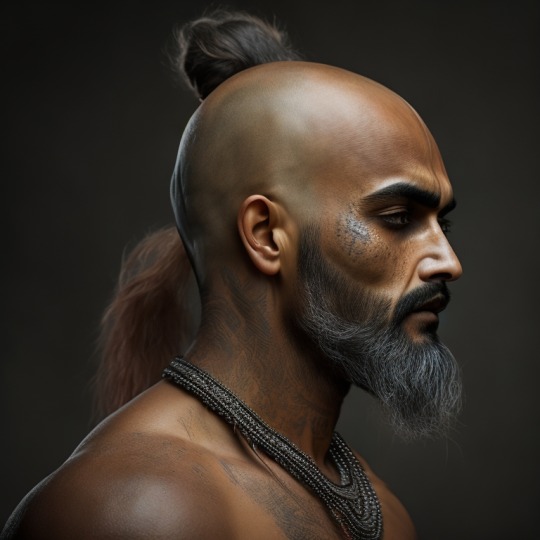
Clothing and Style for Women:
- Sari: A long piece of cloth draped around the body and over the head, showcasing elegance and grace
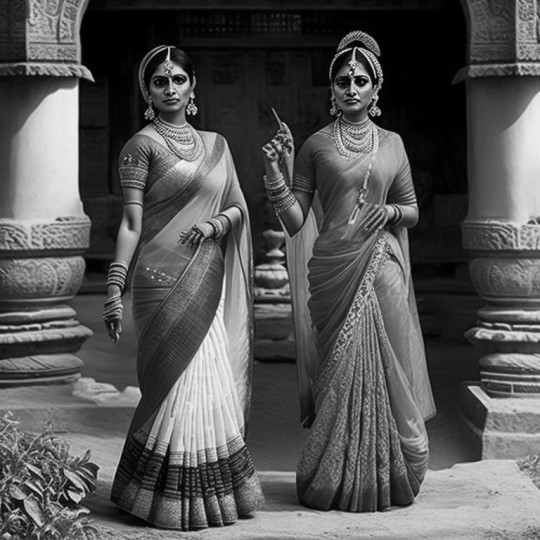
Knee-length skirts paired with intricate jewelry like bangles, earrings, and beaded necklaces.
- Elaborate jewelry made of stones, animal claws, feathers, and shells.
- Handloom textiles woven by skilled artisans.

- Gold ornaments, particularly worn by upper castes.
Sirradai: A short lower garment made of handspun cotton and silk.

Traditional Colors Used in Ancient Indian Clothing:
Ancient Indians were adept at dyeing clothes, and specific colors held symbolic significance:
- Ivory, jasmine, August moon, August clouds after the monsoon, and the color of the peacock's neck were significant traditional colors.
- The Vedic treatise Vishnudharmottara described these hues.
Traditional clothing of india
Men wore a variety of garments depending on their region, occupation, and social status. Some common examples include:
Lungi: A simple garment made of a single piece of cloth wrapped around the waist and legs, similar to a sarong.

Veshti: A long piece of cloth wrapped around the waist and legs, similar to a dhoti but without the pleats.

Angrakha: A long tunic with a V-shaped neckline that is worn over a dhoti or other lower garment.
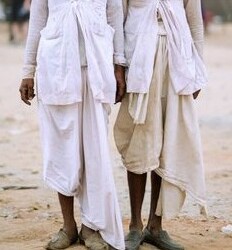
Sherwani: A long coat-like garment that was often worn for formal occasions.


Pajama: Loose-fitting pants that are typically worn with a kurta or other upper garment.
It's worth noting that the styles and materials of these garments varied widely depending on the time period and region in which they were worn.
Conclusion:
Ancient Indian clothing showcased the richness of culture, history, and artistry. Through the ages, men and women draped themselves in garments like dhotis, saris, turbans, and knee-length skirts, reflecting their customs, traditions, and social status. Warriors donned armor and wielded weapons as they protected their kingdoms. The vibrant colors derived from natural elements added splendor to the attire. The remnants of ancient Indian clothing, discovered through sculptures, paintings, and literature, provide us with a glimpse into the past, where clothing was not merely functional but also an expression of identity and heritage.
#beautyofindia #indianclothing #indianimpact #indianhertage#forgottenbharat
3 notes
·
View notes
Text

Unveiling the Essence of Lungi Mart: Bangladesh's Premier Traditional Clothing Haven
Step into a realm where tradition meets contemporary style – welcome to Lungi Mart, Bangladesh's unrivaled destination for authentic traditional clothing. Nestled in the heart of Bangladeshi culture, Lungi Mart stands tall as the nation's foremost purveyor of timeless attire, catering to the discerning tastes of individuals who cherish heritage and elegance.
In a world where fashion trends come and go, Lungi Mart remains steadfast in its commitment to preserving Bangladesh's rich sartorial legacy. From intricately woven lungis to resplendent saris, each garment at Lungi Mart is a testament to the artistry and craftsmanship passed down through generations.
The journey to Lungi Mart begins with a quest for authenticity. As you step through its doors, you are enveloped in a symphony of colors and textures, each piece telling a story of tradition and heritage. Here, every stitch is imbued with cultural significance, reflecting the pride and heritage of Bangladesh.
At Lungi Mart, diversity is celebrated, and inclusivity is paramount. Whether you're a local enthusiast seeking to reconnect with your roots or a global traveler eager to experience the allure of Bangladeshi fashion, you'll find yourself welcomed with open arms. The store's expansive collection caters to all ages, genders, and preferences, ensuring that everyone can find their perfect ensemble.
What sets Lungi Mart apart is not just its unparalleled selection but also its unwavering commitment to quality. Each garment is meticulously crafted using premium materials and techniques passed down through centuries. From handloom weaves to intricate embroidery, every detail is carefully considered to ensure the utmost comfort, durability, and elegance.
But Lungi Mart is more than just a clothing store – it's a cultural hub, a place where communities gather to celebrate their shared heritage. From fashion shows showcasing the latest trends to workshops preserving traditional weaving techniques, Lungi Mart is a beacon of cultural preservation and innovation.
In a world dominated by fast fashion and fleeting trends, Lungi Mart stands as a bastion of timeless elegance and enduring style. Here, fashion is not just about what you wear – it's a reflection of who you are and where you come from. With Lungi Mart, you don't just buy clothing; you invest in a piece of Bangladesh's rich cultural tapestry.
So, whether you're a connoisseur of tradition or a curious explorer seeking to uncover the treasures of Bangladeshi fashion, let Lungi Mart be your guide. Step into a world where heritage meets modernity, and experience the magic of Bangladesh's No. 1 traditional clothing store. Experience Lungi Mart – where tradition never goes out of style.
0 notes
Text
Buy handloom lungies online shopping
Buy handloom lungies online shopping - Discover the charm of handwoven craftsmanship with our authentic and timeless collection of handloom lungies. Shop now to experience traditional comfort and cultural heritage at its finest. Elevate your style with handpicked designs, and enjoy the convenience of shopping for handloom lungies online. Embrace the elegance of handwoven textiles and make a statement with your wardrobe.
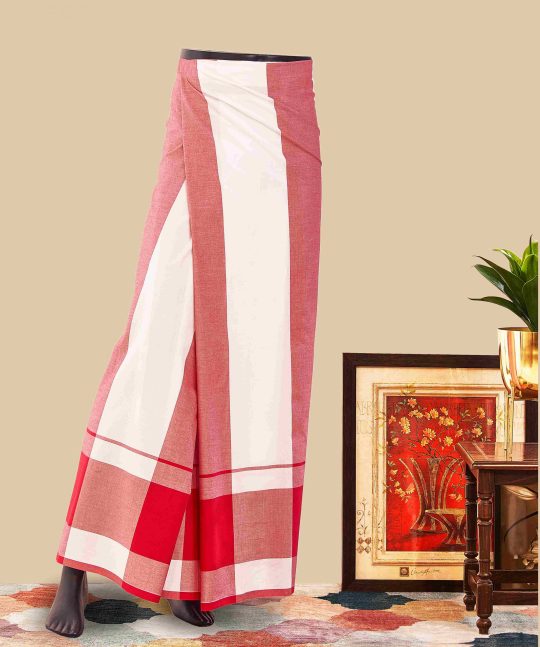
Shop now:https://nayakfashions.com/buy-handloom-lungies-online-shopping-2/
0 notes
Text
Buy handloom lungies online shopping
One of the most comfortable, soft, Handloom lungi is the Nayak Fashion lungi. It is basically a cotton-based lungi. It is made of high-quality 100% high-quality cotton fabric. Its cloth is very light and soft. It is ideal for the summer season because of its properties. It is usually used for traditional Lungi like Sattai Lungi and Dhoti Lungis.
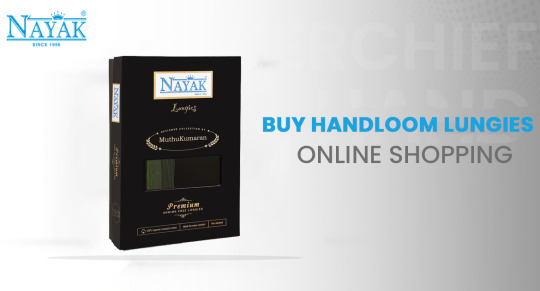
0 notes
Text
7 Indian Groom Fashion Ideas For Your Wedding Ceremonies
When it comes to weddings, bridal trends capture half of our attention, and there are countless articles and blogs that provide information on the latest trends and styles for the bride. But why should a bride receive all the attention and compliments? The groom's fashion has evolved in tandem with the bridal fashion over the years. Colors, silhouettes, styles, and accessories have all changed, and we're here to help you navigate it all.

A Guide to Indian Groom Fashion and Traditions
The Indian groom's attire is no longer limited to traditional kurta pajamas or handloom lungi online or a black-tie suit for the reception party. Men nowadays are conscious and aware of current trends. Just as we've seen brides who like to experiment and go for something different, men want to look their best on their wedding day. If you are a groom-to-be, here are some outfit options for your wedding events that you can choose from without wasting time.
1. The Classic Sherwani
Sherwani is a traditional ethnic wear for men that is appropriate for almost any cultural event or festival. It is a knee-length button-down jacket worn over a kurta and paired with a flared trouser, pajama, or dhoti. There are numerous options available, including fabric, silhouette, embellishments, embroideries, and how the sherwani is styled. When you see a groom in a sherwani, you get a royal and elegant vibe.
If you like to experiment, try floral prints or a velvet fabric sherwani, and finish the look with a beautiful shawl or stole. If you do not have a stole or shawl, choose a safa with a long tail.
2. Angrakha Kurta
The angrakha kurta is ideal for the groom who prefers a sophisticated style with a unique element to make their entire look stand out. Angrakha can be worn with a straight A-line, an asymmetrical cut, or a flowy Manarkali style cut. A pair of dhotis looks fantastic with the knee-length Angrakha. You can also pair it with flared or sharara pants.
3. Jodhpuri Suits
Nothing beats Jodhpuri suits when it comes to elegant groomswear. Any man wearing this exudes a chic and royal appearance. It is classified as Indo-western wear because it is influenced by western tailoring techniques and Indian bandhgala jackets. The collars are high, and the suits are not embellished in general, but are rich in fabric and texture, and are paired with tailored fitted trousers. There is a place for pocket squares that reflect the western side, and you can complete your look with accessories such as pocket chains, necklaces, cufflinks, embellished buttons, and so on, and finish with formal shoes or Indian jootis.
4. Draped Asymmetric Kurta
The draped kurta is ideal for grooms who do not want to carry a stole or shawl but want to add a flowy touch to their look. The drape can resemble a pleated fabric hanging from one or both shoulders. The lower side of the kurta with white cotton lungi online has a cowl structure, which gives this kurta a distinct look. You can wear it with Nehru jackets, bandhgala waistcoats, or even long jackets, and for pants, go for fitted trousers.
5. Bandhgala Suit
We've all heard of Bandhgala coats or short button-down kurtas to wear over long kurtas or Manarkalis, but this time we're talking about calf-length Bandhgala suits, which are popular among Indian grooms. You can't possibly go wrong with this suit. When you can't think of anything else to wear, this is your go-to outfit. You can select from a wide range of colors, fabrics, and even prints or embellishments.
Choose a Bandhgala suit in a solid color, pair it with off-white or printed safa, and finish the look with a brooch or a neckpiece.
6. Kurtas
A kurta is yet another traditional outfit for Indian men. This is a no-brainer outfit that requires no styling. A kurta is a fashion statement that will never go out of style. You can wear it with anything and everything and look fantastic! A simple kurta pajama with trousers or a dhoti is a popular yet stylish ethnic wear for men.
A kurta with denim pants is also popular these days, but as a groom, flared trousers or a churidar look best.
A kurta with dhoti pants or patiala salwar looks good, but adding a stole elevates the look.
You can also wear a basic kurta with printed waistcoats, short bandhgalas or angrakhas, or with a shawl.
7. South Indian Dhoti with Silk Shirt
How can we discuss Indian groom fashion without mentioning the South Indian groom style? South Indian wedding fashion differs from that of most other communities, as do their outfits. Their go-to groom attire is a silk white shirt with a white dhoti or lungi. And the simplicity of this attire is what distinguishes it as special and unique, perfectly complementing the traditional South Indian bridal ensemble. Sometimes the groom foregoes the simple shirt in favor of a short kurta or achkan that matches the dhoti or lungi. The key is to style it your way while retaining the essence of traditional attire.
Conclusion
It is not true that grooms have fewer options than brides. Indian fashion, particularly wedding fashion, has evolved over time, and there is no longer a rulebook to follow. Designers are creating fashionable groomswear and accessories for men to select and style for their wedding events. Where designers are making a name for themselves, men are generally concerned with their appearance at weddings. They are just as invested as the bride in looking and feeling good.
We hope this Groom fashion guide assists you in determining your outfit and determining your style for each event at your wedding and capturing all of the attention because, after all, why should girls have all of the fun?
0 notes
Photo

Buy handloom lungies online shopping is the best place to purchase handloom lungies online. The online store offers a wide range of handloom lungies in different colors, designs, and fabrics. Handloom lungies are available at this online store at very reasonable prices.
0 notes
Text

Types of handloom products exported by India:-
Handloom business in India has been carried by lakhs of artisans across India and is one of the most widely unorganized economic activities. It comprises 23.77 lakh looms, employing more than 3 million people in direct and allied activities. India produces many traditional handloom products such as sarees, kurtas, shawls, ghagra cholis, lungis, fashion accessories, bedspreads, etc. Indian silk scarves are popular all over the world. Panipat, Karur, Varanasi, and Kannur are the major handloom export cities. To know more, visit India Brand Equity Foundation website.
#handloom_clothes#Indian_handloom#handloom_products#handloom_business_in_India#handloom_weavers_in_India#handloom_manufacturers_in_India#Indian_handloom_products
0 notes
Text
Perfect Guide to Kurta for Men
Kurtas are highly valued and recognised in India and other South Asian countries as one of the go-to outfits for anything casual, religious, or wedding-related. Kurtas are both comfortable and simple to wear. Kurtas are particularly popular among both men and women in India. You can dress up your kurta in any way you want by using the right designs, fabrics, and accessories. However, for weddings or parties, men and women typically prefer more colourful and vibrant designs. Here we will discuss some of the different types of kurtas for men paired with handloom lungi online and how to wear them.

Let us first look at some of the different types of kurtas on the market:
Cotton Kurtas For Men With Salwar:
A two-piece kurta set can completely transform your look in seconds and provide you with the desired finish. Furthermore, the cotton fabric can be comfortable enough that you can do your work without difficulty. If you decide to give it a shot and ultimately choose it, be prepared to receive compliments.
Half Sleeves Striped Kurtas:
These kurtas can add a different charm to your look with their distinct style. The half sleeves are there to provide you with extra comfort, while the stripes are your day's hero. These kurtas will be more appropriate for casual occasions where you can meet up with friends or family and enjoy your day without feeling uncomfortable. If it's cotton, you can relax for the rest of the day, and don't forget to check the fabric before purchasing any of these.
Asymmetrical Kurtas:
These kurtas can be a mix of traditional and modern styles. It adds a touch of class and variety to your ensemble. This kurta will look great without any heavy accessories or embellishments, and if you want to look like a star and stand out from the crowd, this is the one for you. These types of kurtas are ideal for any occasion or ethnic party where you want to look stunning with your style. Wear them with a pair of simple juttis and a matching churidar.
Plus Size Casual Kurtas For Daily Wear:
Being a person who needs to purchase plus size items does not imply that you must sacrifice your style or desires. Everything is at your fingertips with a single click of your fingers. There are numerous plus-size clothing options available to you. Simply put forth the effort to search as thoroughly as possible, and you will undoubtedly find the ideal kurta for your occasion. With such kurtas, a brooch can add a touch of ethnicity to your perfect look.
Denim Kurta With Chinese Collar:
Are you someone who enjoys both traditional and denim outfits? Kurtas, on the other hand, can provide you with both. If you're going to an ethnic or casual party, these kurtas will come in handy. You'll be fine if you wear the appropriate shoes or sandals.
Bandhani Kurtas:
Give this desi look a shot; you will not be disappointed. These kurtas are typically made of cotton to provide that extra touch of comfort and satisfaction. It will look great paired with the appropriate ethnic footwear.
Indo Western Kurta For Men:
The Indo western kurta will provide you with the perfect balance of modernism and traditionalism. Celebrities typically wear these kurtas over cotton vests to special occasions. These are ideal for weddings, receptions, and private parties. Depending on the style and colour of your kurta, a good pair of mojaris and churidar pants will complete the look.
Shirt Kurtas For Men:
If you want to stay cool all day, shirt kurtas are ideal for a long summer day. They are the ideal combination of an Indian kurta and a western shirt. It is similar to other kurtas, but the length is the only difference. It is available in a variety of colours such as white, blue, and others, with a wide range of combinations. Pair it with a good pair of sandals, denim, or trousers, as desired.
Some Of The Kurta Styles For Men:
Pathani Kurta:
Pathani kurtas are those that have a collared neckline and fall below the knee. These kurtas can be both comfortable and appealing, so don't pass them up. Apply a strong perfume before going out, and you'll look amazing.
Men’s Printed Kurta Pyjama:
If you want to give your outfit a traditional yet stylish look, printed kurtas are the way to go. You can mix and match as much as you want for your day, and don't forget to add a contrasting pair of pyjamas to complete the look. Accessorize with the right sunglasses and kolhapuris to complete the look.
Bandhgala Kurta Pyjama:
Bandhgala blazers are buttoned up to the neck and can be worn with a simple kurta underneath. This kurta is well-known for keeping you warm and out of the cold during the winter. These are ideal for winter weddings, but you can wear them anywhere you want as long as you keep the heat in mind.
Churidar Kurta Pyjama For Men:
These kurtas are paired with a hip-length tailored waistcoat to complete your look. Pair it with a Nehru jacket over a nice pair of silk set to make a lasting impression. Don't forget to match it with the appropriate pair of mojaris, sunglasses, and a watch based on the style and colour of your outfit. Remember to keep your hair natural and to go out after applying a light fragrance.
Hope this was useful. Enjoy!!
0 notes
Text


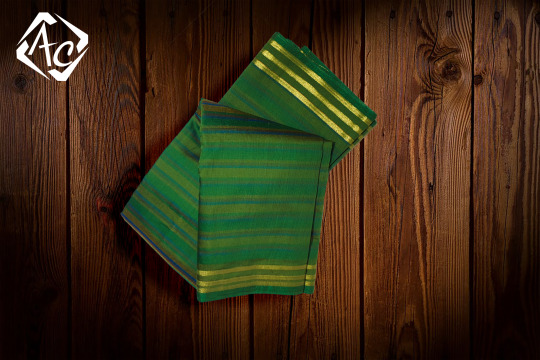
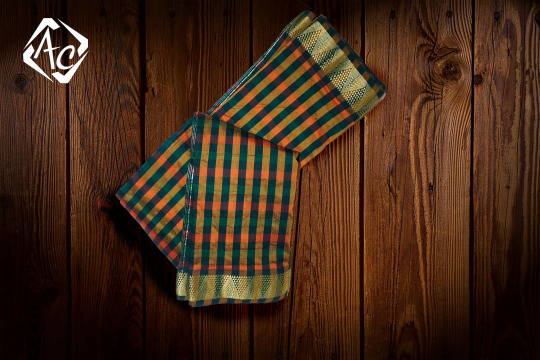





#amrutcreation#handloom#textiles#garment#manufacturing#wovenclothing#firstmanufacturer#supplier#clothing#manufacturespowerloom#cottonsarees#traditionalbath#towels#lungis#plainpowerloomscottonfabric#powerloomfactory#firstandonlyunitinKodagu#specialize#sophisticated#sewingmachines#cutting-edge#creatinguniforms#uniformsschoolsandcolleges#uniformsCorporates#uniformshospitals#uniformshotels#uniformsrestaurantsandautomobile#uniformskhakishirtsandhomeguards
0 notes
Text
Buy handloom lungies online shopping
You may pay using any method using the simple transaction option, including UPI payments, credit cards, debit cards, and cash on delivery for buying Handloom lungies online. Everything is within our power to provide you with the ideal 100% cotton designer lungies. Make your purchase while unwinding; after our delivery person arrives with your order, you may further unwind.
0 notes
Text
Odisha Handloom Pure Cotton Traditional Sambalpuri Ikkat Lungi / Mundu of 2.25 Meters in Multi Colour Combination for Boys & Men by Handloom Saga. SPLG-23
Odisha Handloom Pure Cotton Traditional Sambalpuri Ikkat Lungi / Mundu of 2.25 Meters in Multi Colour Combination for Boys & Men by Handloom Saga. SPLG-23
Price: (as of – Details)
This is a Traditional Authentic Pure Soft Cotton Ikkat Lungi or Mundu of 2.25 meters For Men & Boys by Handloom Saga. Handwoven by our master weavers this lungi is best for Daily Wear or for Casual Wear in this hot summer seaso. Lungi Lengtgh: 2.25 MetersHand woven traditional ikkat designBest for Daily Use, Home & Ethnic Wear.Authentic & Original Odisha Handloom Product.

View On WordPress
0 notes
Text
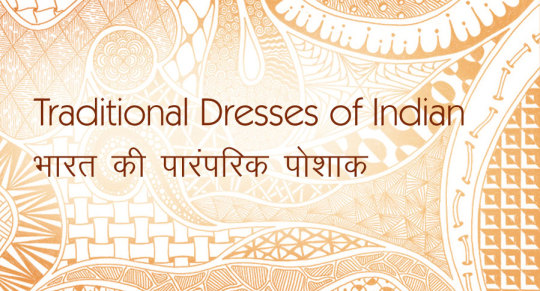
India is a country which is called the land of 'unity in diversity', it is a country of various cultures, traditions, religions, castes, languages, races and ethnic groups. Therefore, the costumes of Indians vary depending on culture, traditions, religions, castes, languages. India is a federal union comprising 28 states and 8 union territories, for a total of 36 entities.
1. Andhra Pradesh:
Andhra Pradesh is a southern state in India. It shares its boundaries with Telangana, Chhatisgarh, and Odisha with the Bay of Bengal in the east. Called the “Rice Bowl of India” as they grow rice in plenty.
Andhra Pradesh is regarded as the Kohinoor of India for its famous weaving and dying industry. The traditional wear of Andhra Pradesh is much the same as other southern Indian states. Men usually wear kurta and dhoti, while lungis are also worn with a kurta. Muslim men wear pajamas with kurta in place of the dhoti.
The women of Andhra Pradesh wear saree and they are original handloom sarees, young women wear Langa Voni. For marriage ceremonies, the bride wears silk sarees which are red and decorated with gold plating, while the bridegroom wears kurta and full-length dhoti.
2. Arunachal Pradesh:
Arunachal Pradesh is the north-eastern state of India bordering with Nagaland and Assam to the south, while Myanmar to the east, Bhutan in the west, and China to the north. Their dresses are very vibrant, bright and their myriad patterns vary with different tribes. The Attire of Arunachal Pradesh is remarkable and famous all over India.
The Monpas, Buddhist community are famous for their skull cap, women wear sleeveless chemise with a long jacket. There is a narrow strip of cloth that they tied around their waist to keep chemise tied in place.
Bamboo earring and silver earrings are very common. Females of tribes residing in lower Kamla valley have a very peculiar costume. They tie their hairs in a knot just above their forehead.
Men wear sleeveless material made of silk with two edges pinned to the shoulder area. The clothing is knee-long and its hallmark is the skull -cap smeared with hairs of yak.
Tang’s tribe people adorn costume which is the style of Burmese. Men wear sleeveless shirt and lungi of green color with white, red, and yellow yarn. Women wear a woven petticoat with a blouse. Miji women wear a long cloak and big earrings.
3. Assam:
Assam is surrounded by seven northeastern states in India. The traditional dress for men is dhoti-kurta while for women they wear ‘Mekhela-Chador‘ or ‘Riha-Mekhela’.
This traditional dress is made from the prestigious ‘Muga Silk‘ which is the peculiarity, as well as the pride of Assam. They also wear ‘Dokhora’ and dresses like a salwar suit, sari, etc. Women feel proud to wear handloom products, especially Mekhela chador, during special occasions like weddings and festivals like Bihu and Saraswati puja.
The women of the Bodo Tribe wear Mekhela paired with a chadar while women of the Thai Phake Tribe wear a striped girdle called Chiarchin. The traditional dress worn by the menfolk of Assam is ‘Suria’ or ‘dhoti’ and ‘kameez’ or ‘shirt’ and over it, a chadar known as ‘Seleng’ is spread.
4. Bihar:
The traditional dress of Bihari people includes the dhoti-mirjai or the kurta for men and Saree for women. The effects of western culture have also affected the lives of the people of Bihar where women prefer to wear saree or Kameez-Salwar.
The saree is worn in the “Seedha Aanchal” style traditionally. Western shirts and trousers are also becoming very popular in both rural and urban male population.
5. Chhattisgarh:
Chhattisgarh is a central state of India. It’s rich in culture, legacy, and enormous diversity of various ethnic sets. Chhattisgarh tribes wear bright and colorful fabrics. They love to wear jewelry on their neck. Chhattisgarh traditional women clothing is Kuchhora style saree. Their saree are knee-length.
Men in tribal groups wear dhotis and headgears like cotton turbans. The fabrics used are linen, silk, and cotton and they are usually painted with molten wax. Their tie and dye technique used in fabrics is called Batik.
6. Goa:
Goa the land of beaches is immensely popular among tourists. The women of goa wear Nav Vari which is a 9-yard saree studded with precious stones and worn with beautiful accessories.
Other women’s traditional costumes are ‘Pano Bhaju‘. The men in goa wear brightly colored shirts, half pants, and bamboo hats.
7. Gujarat:
The traditional dress of Gujarat is unique in its own way. The women wear Chaniyo choli, Chaniyo is a colored petticoat embroidered with glass pieces while choli is a colored piece of coarse cloth covering the upper body.
Along with the colorful attire, women adorn themselves in sparkling ornaments. Men wear Chrono & Kediyu, but nowadays instead of wearing traditional outfits, people dress in modern apparel.
8. Haryana:
Women love to wear colorful dresses. Their basic trousseau includes ‘Damaan’, ‘Kurti’ & ‘Chunder’. ‘Chunder’ is the long, colored piece of cloth, decorated with shiny laces, meant to cover the head and is drawn in the front like the ‘pallav’ of the saree. Kurti is a shirt like a blouse, usually white in color. The ‘Daaman’ is the flair ankle-long skirt, in striking colors.
The men generally wear ‘Dhoti’, the wrap-around cloth, tucked in between the legs with a white-colored kurta worn atop it. ‘Pagri’ is the traditional headgear for men, which is now worn mainly by the old villagers. All-white attire is a status symbol for men.
9. Himachal Pradesh:
The people of Himachal Pradesh mostly wear woolens as its best suited to the climate. Scarves and shawls are ubiquitous with the women while the men can be found in various types of Kurtas and the typical Himachal cap.
The Rajput males comprise starch stiffened Kurtas and body-hugging ‘Churidaars’. The females of this group apparel themselves little conventionally costumes like kurtas (shirt-like oriental blouse), Salwars, Ghaghri (Indian long skirts), a choli (blouses or tops), and Rahide (headscarves decked with golden periphery).
10. Jammu and Kashmir:
The Pheran is the prominent attire for Kashmiri women. The Pheran is worn by women usually has Zari, embroidery on the hemline, around pockets, and mostly on the collar area. Ladies prefer a suit and Burgha in summer and Pheran are preferred in autumn.
The typical dress of a Kashmiris man both Hindu and Muslim is Pheran, a long loose gown hanging down below the knees. The men wear a skullcap, a close-fitting shalwar (Muslims), or churidar pajama (Pandits).
11. Jharkhand:
On auspicious occasions in Jharkhand like Pooja Text or Wedding Vagera, people wear their local traditional clothes like kurta, pajamas, lehenga, saris, dhoti, sherwani, etc. Tussar silk sarees are made in Jharkhand, known for their elegance and unique look. Tribal women wear Parthan and Panchi.
But nowadays people have moved on from wearing traditional dresses to adopt western culture garments. People here started wearing jeans, t-shirts, shirts, lower, jackets, belly, blazer suits, etc.
12. Karnataka:
The traditional clothing for women in Karnataka is a saree made of silk. Karnataka is known as the Silk hub of India as a wide variety of silk can be found here. Mysore and Banglore are mainly famous for their silk industries.
Kanchipuram or Kanjeevaram silks of Karnataka are very famous all over India. The traditional dress for men in Karnataka is Lungi, worn under the waist below a shirt. Mysore Peta is a conventional headdress for men.
13. Kerala:
The traditional clothing of women in Kerala is the ‘Kerala Saree’ or the Mundum Neriyathum. This is in two pieces, one is draped on the lower part of the body and then the neriyathu is worn over a blouse.
The men of Kerala tend to be more conservative than women and stick to tradition. Mundu is worn on the lower part of the body and is a long garment tucked around the waist, it reaches their ankles. Many prefer to wear it above their waist and the higher caste drape a cloth over their shoulders.
14. Madhya Pradesh:
Women of Madhya Pradesh wear Lehenga and Choli with an Orni or Lugra, which is additional cloth wrapped around their heads and shoulders. Whereas the male community wears dhoti along with Bandi, which is a kind of jacket and headgear.
15. Maharashtra:
Traditional clothes for Maharashtrian males include the dhoti, also known as Dhotar, and pheta, while a choli and nine-yard saree locally known as Nauwari Saadi or Lugda are for women.
Traditional clothing is famous in rural areas while traditional people from cities also wear these clothes. These clothes are worn by Maharashtrians while performing various festivals.
16. Manipur:
Innaphi and Phanek are the Manipuri traditional dress for women in Manipur. A shawl or dupatta called Innaphi and a skirt called a Phanek, which is wrapped around the chest. The dress is woven with a hand in horizontal lines.
Men wear dhotis which is four and a half meters long. These are wrapped around the waist and legs and knotted at the waist, and paired with smart jackets or bundis. Headgear is a white pagri or turban.
17. Meghalaya:
Meghalaya has three main tribes Khasi, Jaintias, and Garos, and the traditional dress of each tribe is peculiar. The traditional Khasi female dress is called the Jainsem or Dhara, both of which are rather elaborate with several pieces of cloth, giving the body a cylindrical shape. The traditional Khasi male dress is a Jymphong, a longish sleeveless coat without collar, fastened by thongs in front.
A Garo woman also wears a blouse and an unstitched ‘lungi’ like cloth which is known as ‘Dakmanda.’ It is fastened around the waist. Both Garo men and women enjoy adorning themselves with ornaments. The women of the Jaintia tribe wear a velvet blouse along with a sarong called ‘Thoh Khyrwang’ which is wrapped around the waist.
18. Mizoram:
Mizo women love to wear Puran, which is the most favorite dress in Mizoram. The lively color and the exceptional designs and fittings made this outfit superb. Puanchei, the gorgeous dress of Mizo girls is a must during weddings and festivals such as ‘Chapchar Kut’ and ‘Pawl Kut ‘. The shades in the attire are black and white. The black portion of the textile is originated from some kind of synthetic fur. Kawrchei is a fabulous blouse for Mizo girls. That also is hand-woven and cotton material.
19. Nagaland:
Naga has Red as the most primary color in costumes. The traditional dress material and costume of the Angami men are kilt and wrapper, while the women use a skirt, shawl, and apron. Most of the women, unlike men, wear traditional dresses. A kilt looping down to the knee is a man’s typical waist dress which is of light blue color.
A women’s skirt is a sheet of cloth that is used by rolling it along the waist and which loops down to cover legs. Neck ornaments are mainly strings of beads, shells, boar’s tusks, and horns.
20. Odisha:
In Odisha western-style dress has gained greater acceptance in cities and towns among men, although the people prefer to wear traditional dresses like Dhoti, Kurtha, and Gamucha during festivals or other religious occasions. Women normally prefer to wear the Sari (Sambalpuri Sari) or the Shalwar kameez; western attire is becoming popular among younger women in cities and towns.
21. Punjab:
The traditional dress for women is the salwar suit which replaced the traditional Punjabi ghagra. The Punjabi suit is made up of a kurta or kameez and a straight cut salwar. The Patiala salwar is also very popular in India.
The traditional dress for Punjabi men is the kurta and tehmat, which is being replaced by the kurta and pajama, especially the popular muktsari style in India. It is called muktsari style because it originates from Muktsar in Punjab.
22. Rajasthan:
raditionally men wear dhotis, kurta, angarkha, and paggar or safa (kind of turban headgear). Traditional Chudidar payjama (puckered trousers) frequently replaces dhoti in different regions. Women wear ghagra (long skirt) and kanchli (top). However, dress style changes with lengths and breaths of vast Rajasthan. Dhoti is worn in different ways in Marwar (Jodhpur area) or Shekhawati (Jaipur area) or Hadoti (Bundi area).
23. Sikkim:
The traditional costume of Lepcha women is called Dumvum or Dumdyam. It is an ankle long costume worn like a sari. Another costume worn is Nyamrek which is beautifully attached to the blouse. another community Bhutia wear Bakhu or Kho costumes. It is a loose, cloak-style garment that is fastened at the neck on one side and near the waist with a silk or cotton belt.
Male members wear loose trousers under the Kho. The traditional outfit is complemented by embroidered leather boots by both men and women.
24. Tamil Nadu:
In Tamil Nadu women wear sarees. The young girls wear full-length short blouse and shawl, this style of wearing is called Pavada, which also known as a half sari. Now, most of the women in cities are wearing Salwar Kameez, Jeans, and Pants.
The Tamil Nadu men are usually seen dressed in Lungi along with a shirt and Angavastra. The traditional Lungi originated in the South and it is simply a short length of material worn around the thighs like a Sarong. A Dhoti is a longer Lungi but with an additional length of material pulled up between the legs.
25. Telangana:
Telangana is rich in cotton production and its innovative plant dye extraction history stands next to diamond mining. Traditional Women wear a sari in most parts of the state. Langa Voni, Shalwar kameez, and Churidaar are popular among the Unmarried Women.
Some of the famous sarees made in Telangana are Pochampally Saree, Gadwal sari. Male Clothing includes the traditional Dhoti also known as Pancha.
26. Tripura:
The dress for women for the lower half of the body is called Rigwnai in Tripuri and for the upper half of the body, the cloth has two parts Risa and Rikutu. Risa covers the chest part and the rikutu covers the whole of the upper half of the body. Nowadays risa is not worn, instead, a blouse is worn by most Tripuri women because of convenience.
The male counterpart used to wear ‘rikutu’ for the loin and ‘kamchwlwi borok’ for the upper part of the body. But in the modern age, very few people are wearing these dresses except in the rural Tripura and working class.
27. Uttar Pradesh:
The costume of Uttar Pradesh is a very typical one where the women are clad in their saris adorned by the golden jewelry and Mangal Sutra (a chain with a pendulum gifted by the groom to his bride) worn by married women while the men look clad in dhoti kurta or kurta pajama. Toe rings are common all over the Uttar Pradesh among the married woman folks.
28. Uttarakhand:
Dress for females is Ghagara, Aagari, Dhoti Kurta, Bhotu. While for males churidar pajama, Kurta, gol topi or Jawahar topi, Bhotu, Dhoti, Mirje are worn. Dhoti or Lungi is worn by men as a lower garment, with kurta as the upper garment. Men also like to wear headgear in Garhwal.
29. West Bengal:
Bengali women traditionally wear the sari and shalwar kameez. The traditional dress for men like a dhoti, Panjabi, kurta, sherwani, pajama, and lungi are seen during weddings and major festivals.
1 note
·
View note
Text
Exploring the World of Men's Wear
The various varieties and styles of clothing in men's wear make it difficult to identify a single source of fashion influence. A thoughtful blend of cultural, traditional, and modern influences results in an exciting array of men's wear. It can accommodate casual, formal, and semi-formal events.
Clothing provides Indian men with the same opportunity to express their personality and embrace their culture as it does for women. The sheer style of the designs, motifs, patterns, textiles, and cuts is impressive. Men's clothing comes in a variety of traditional and regional styles. Several of these are only worn for special occasions in specific communities and areas, while others have transcended their regional origins to become universally fashionable. For example, the sherwani worn over cotton vest is now worn by men all over the world for special Indian occasions. It is preferred for its royal cut and ornate style, and the fact that it was once the preferred outfit of royalty adds to its allure. It is also one of the most popular wedding outfits for men. Wedding versions are typically much more opulent. They are made of heavy brocades and intricate embroidery.
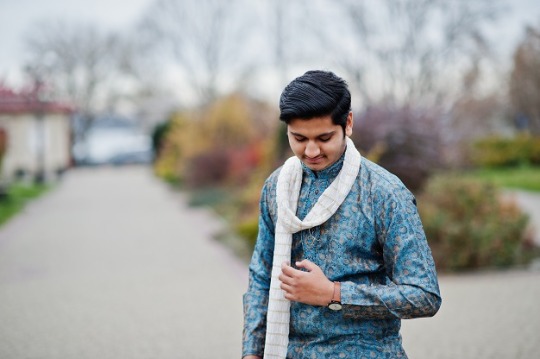
The kurta pyjama is another universally popular piece. This is appropriate for both casual and formal occasions. The main appeal of this garment is its comfort and versatility. It will be made of a variety of materials, including khaddar and cotton, as well as jute, silk, and even georgette. Men will opt for traditional, neutral-toned kurtas in grey, white, or beige, or for funky printed kurtas with eye-catching graphics and motifs. The younger generation enjoys experimenting with Indo-Western styles; the kurta and jeans look has become very popular in recent years.
Men's Indian wedding outfits feature the most traditional styles and designs. Though good Indo-western garbs like Nehru jackets or modern style kurtas are increasingly becoming a wedding wear trend among men, traditional clothes still reign supreme. For example, in many cultures and communities, the dhoti kurta ensemble is required at weddings. One of the most distinctive garments is the dhoti. It's essentially a long, rectangular piece of fabric draped around the legs in a trouser-like form and tucked around the waist.
Men's Ethnic Wear Give Your Personality a Majestical Touch
The best formal attire is unquestionably ethnic wear. These are considered the best outfits to wear for festivals, wedding ceremonies, and other auspicious occasions.
Men's ethnic wear is divided into two categories. The first is the sherwani, and the second is the kurta pyjama. These outfits contribute to the charm of men's personalities. These outfits are fit for royalty. Males prefer to wear these because it adds flair to their appearance. The men get the most enthralling looks when they wear this collection.
The men's sherwani is essentially a long coat. It looks great with the designer kurta and churidar pyjama. Wear it with the stole and mojari to add more charm to your personality. This outfit will make you look like a royal prince.
The design of the designer sherwani has changed dramatically as new fashion trends emerge. The designers are working hard to create collections that reflect the most recent fashion trends. Designers used to create their collections in traditional colours back in the day. Buyers' and wearers' preferences have shifted dramatically in recent years. Understanding buyer preferences has become extremely difficult. To meet their exact specifications, the designers offer their collections in stunning colour combinations.
Colors play an important role in expressing the festivity of the occasion. As a result, the designers use an intriguing range of motifs to create the collections. The printed designs, which are created in appealing patterns, are provided on the fabric to add charm to the collection.
The embroidery has become an essential component of the designer sherwani paired with handloom lungi. Handmade artwork of decorative items such as beads, sequins, and stones is widely used in this to add elegance to the collection. This collection is popular among men because of its charismatic designs.
This collection also includes designer kurtas. It is a long tunic that is worn with pyjamas. This collection is available in a wide range of designs and colours. This not only provides the wearer with fashionable looks, but also reflects rich traditions. While designing this collection, the designers made extensive use of intriguing colour combinations. Aside from that, zari artwork is provided along the length and breadth of the fabric. This contributes to the collection's elegance.
You can easily find a wide selection of men's ethnic wear online. This collection is available at competitive prices from a variety of online stores and leading brands. Buying online allows you to get the desired collection with a single click of the mouse.
#fashion#traditional#cotton#clothing#style#fabric#colors#design#collection#kurta#wedding#embroidery#sherwani#trends#ethnic wear#festivals
1 note
·
View note